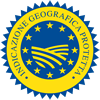Description
Moutarde de Borgogne IGP is a paste made with moustard seeds which come from the species Bassica Juncea (brown and white moustard) and Bassica Nigra, water, white wine, salt, sugar, spices and additives.
Production Area
The production area of Moutarde de Bourgogne IGP consists of the départements making up the Burgundy region: Côte d'Or, Nièvre, Saône and Loire, and Yonne. The geographical area was established on the basis of special local know-how in Burgundy in the production of mustard seeds and wine.
Production Method
There are several phases in Moutarde de Borgone IGP production. After the certification, the steeds are crushed and brought into contact with the dilution liquid, made with water and white wine. The wine has the protected designated origin and it is produced in the Burgundy winegrowing area. It has to be a white and dry wine from Agolitè or Chardonnay grapes. They are noted for their powerful aroma and long finish flavour. In Moustarde de Bourgogne IGP the minimum proportion of wine is 25 % during dilution. During this stage, the kernel is removed from the seed and an initial mustard paste is produced. This paste is then sieved to remove the seed coats. The result is a pale yellow paste with a uniform, thick, creamy texture, which is 'de-aerated'. Then follows a rest period to allow the mustard to develop a sharp taste. The paste is then stored and packaged.
Appearance and Flavour
Moutarde de Bourgogne IGP is a strong or extra-strong yellow paste with a uniform, thick, creamy texture. The taste is intensely sharp, with a strong flavour of white Burgundy.
History
We have reports about Moutarde de Bourgogne IGP since 1336. Historical sources say that a large cask of mustard was consumed at a feast organised at Rouvres. Back in the 16th century, statutes were laid down to define the mustardmakers' guild. Up until the 19th century, mustard was manufactured in small workshops, then the industrial revolution began to affect the industry of this paste. During the second World War the production of moustard was very important in Bourgogne Country, but it became more relevant in 1990s. At that point in time the entire sector shared the same concerns to encourage the moustard production.
Gastronomy
Once opened, the Moutarde de Bourgogne IGP has to stay in fridge. The glass or terracotta package has to stay always close to preserve the spicy flavour. To avoid that the paste become dry, is possible to cover the moustard with a clove of lemon, that has to be changed frequently. It's also important to keep the paste away from light and heat. Moutarde of Bourgogne IGP doesn't need other cooking processes once packaged. Moutarde de Bourgogne IGP can be tasted with fish or with white or red meat, combined with white wine produced in Burgundy grape area or with fruit flavour red wine.
Marketing
The product is sold as Moutarde de Bourgogne IGP. The Moutarde de Bourgogne IGP is packaged in glass or terracotta vase.
Distinctive Features
The quality of Moutarde de Bourgogne IGP is also given by the rich potassium soil of the Burgundian Country. In addition, the quite uniform, semi-continental Burgundian climate is suited to mustard-growing.






